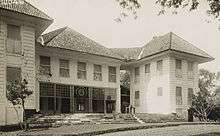Groeneveld (estate)

Groeneveld (Dutch "green field") was an estate located in Jatinegara, East Jakarta, Indonesia. The estate contains an 18th-century Dutch colonial manor house known as Groeneveld Huis or Tandjong (Tandjoeng) Oost ("east cape") Huis, being located on the east side of the Ciliwung. The house was burned in 1985 and is now left to deteriorate.[1][2]
History
The first owner of the estate is Pieter van de Velde from Amersfoort, member of the Raad van Indië.[3] After the 1740 Batavia massacre, van de Velde managed to acquire a land owned by Captain Ni Hu-Kong and some other lands south of Meester Cornelis (now Jatinegara) on the east of Ciliwung, forming a new estate known as Tandjoeng Oost ("east cape"). He built a manor house in 1756 on this plot of land. Peter Van de Velde died in 1759. The second landowner was Adrian Jubbels, who acquired the estate in 1763.[3] After the death of Jubbels, the land was acquired by Jacobus Johannes Craan in 1763. He renamed the estate Groeneveld (Dutch "green field") and renovated the villa with new ornaments in the style of Lodewijk XV and Chinese-inspired ornaments on the doors and windows. The ornaments was visible until the entire resident is burned in 1985.[4][5]
After Craan died in 1780, The Groeneveld estate passed to his daughter Catharina Margaretha Craan, and so it was acquired by her husband Willem Vincent Helvetius van Riemsdijk, second son of Governor General Jeremias van Riemsdijk. Willem Helvetius van Riemsdijk himself had already acquired high position since his young age; at 17 he was the administrator of Onrust Island, and he owned many lands and sugarcane plantations among which are Tanahabang, Cibinong, Cimanggis, Ciampea, Cibungbulan, Sadeng, and Tandjoeng Oost. The lavish property, center to the trade and colonial power, remains to the family of Riemsdijk until the start of the World War II.[3]
The land was improved by Daniel Cornelius Helvetius, who developed agriculture in Tandjong Oost until his death in 1860 when the Groeneveld Estate was given to his daughter Dina Cornelia. Dina Cornelia married Tjalling Ament of Dokkum. Ament continued the agricultural business in Groeneveld. By the middle of 19th-century there were 6000 cattles in Tandjong Ooest. Until 1942 the Van Riemsdijk family maintained the estate, the developing local settlements around the estate was known as Kampung Gedong, after the manor house building (gedong), being the largest building in that area. The local inhabitants of the kampung is known as Betawi Condet, which develops their own distinctive Betawi culture.[4]
During World War II, the villa was used by Japanese occupants as a warehouse. After the World War II, the building gained historical significance when it became the headquarters of Barisan Pelopor, an underground movement against the Japanese occupation, which was led by Sukarno who later became the first president of the new country. After the first Dutch aggression in 1947 and the second aggression in 1948, the villa was taken over by the Netherlands Indies Civil Administration who turned it into a rubber plantation.[6]
Lastly the estate was purchased by Haji Sarmili where it become a hotel and then an office building. in 1962, Sarmili sold the property to Jakarta Police.[6] In May 1985, the building caught fire as a result of an explosion in the kitchen. The building is now destroyed with no maintenance. The status of the land is protected, but the structure remains seriously neglected. It is now within the houses of officers of the Tanjung Timur police precinct.[6]
The estate
The estate contains a two-storey manor house in a style known as the Old Indies Style. It shows combination of Dutch, Chinese, and local architecture. The architecture is similar to the building of National Archives of Indonesia, which is relatively ancient.
The main building consists of three pavilions. The doors of rooms were decorated with carvings of teak with plant motifs; above the main entrance, the ornament is adorned with a crane, symbol of the Craan family. There were family cemetery in the ground of Groeneveld.
See also
References
- ↑ . Mengintip Sisa Rumah Tuan Tanah di Pasar Rebo. Detik News. Retrieved February 12, 2015.
- ↑ . Landgoed Groeneveld. Familie Wiki. Retrieved February 12, 2015.
- 1 2 3 Landgoed Groeneveld. Gallus Magnus.
- 1 2 Abdul Majid's blog
- ↑ . A beautiful Dutch villa in ruins. Jakarta Post. Retrieved February 12, 2015.
- 1 2 3 Beautiful Dutch Villa Ruins. Jakarta Post.
Coordinates: 6°18′10″S 106°51′23″E / 6.30278°S 106.85639°E